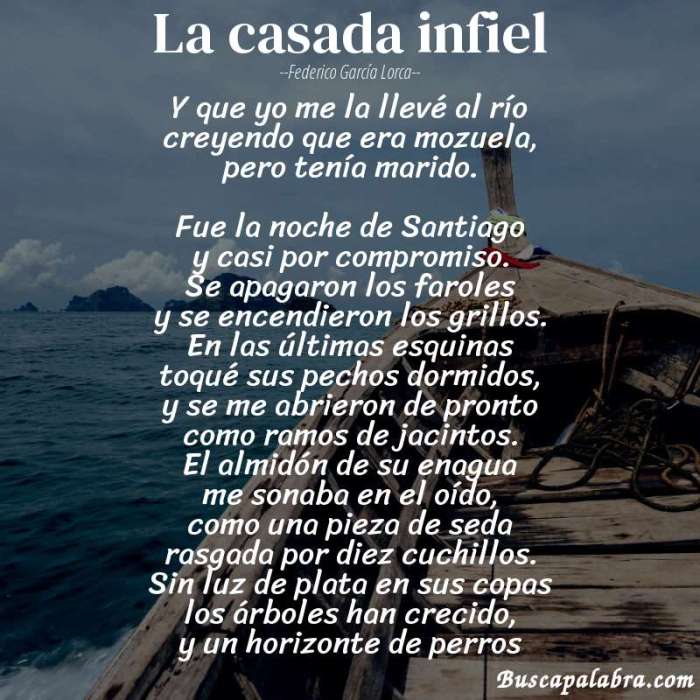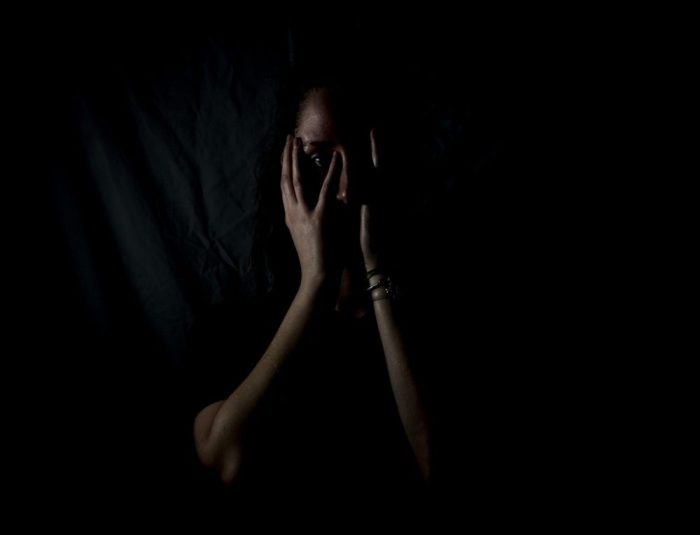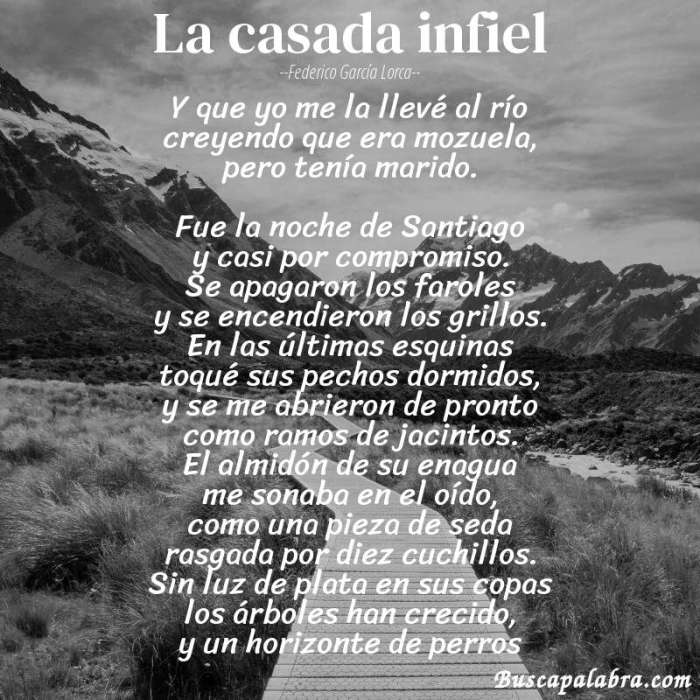La casada infiel garcia lorca – Prepare to be captivated by “La Casada Infiel,” a poetic masterpiece by Federico García Lorca that seamlessly blends modernism and surrealism. This captivating work of art invites us to explore the depths of unrequited love, societal constraints, and the alluring embrace of nature.
Lorca’s use of vivid imagery, evocative metaphors, and enigmatic symbolism paints a vibrant tapestry that transports us into the heart of this timeless tale.
Lorca’s Poetic Style
Federico García Lorca’s poetry is characterized by a unique blend of modernism and surrealism. His modernist influences can be seen in his use of free verse, fragmented imagery, and urban settings. At the same time, his surrealist influences are evident in his exploration of the subconscious, his use of dream imagery, and his juxtaposition of seemingly unrelated objects and ideas.
Imagery
Lorca’s poetry is rich in imagery, often drawn from the natural world. He uses vivid and evocative language to create a sensory experience for the reader. For example, in his poem “The House of Bernarda Alba,” he describes the house as a “white cube,” “a tomb,” and “a prison.”
These images convey the oppressive and suffocating atmosphere of the house and the lives of the women who live there.
The poem “La casada infiel” by Garcia Lorca captures the emotions of a woman who is torn between her duty and her desires. This poem is a classic example of Spanish literature and is often studied in schools. For those who want to delve deeper into the intricacies of the poem, Wordly Wise Book 4 Lesson 10 provides an in-depth analysis of the poem’s themes, symbols, and language.
Returning to “La casada infiel,” Lorca’s use of vivid imagery and symbolism creates a powerful and haunting narrative that explores the complexities of human relationships.
Metaphor
Lorca also makes extensive use of metaphor. He often uses metaphors to compare two seemingly unrelated things in order to create a new and surprising image. For example, in his poem “The Ballad of the Moon,” he compares the moon to a “dead woman” and a “bride.”
This metaphor creates a powerful and haunting image of the moon as both a symbol of death and of life.
Symbolism
Symbolism is another important element of Lorca’s poetry. He often uses symbols to represent abstract ideas or emotions. For example, in his poem “The Lament for Ignacio Sánchez Mejías,” he uses the bull to symbolize the poet’s own mortality. The bull is a powerful and dangerous animal, and its death represents the poet’s own fear of death.
Thematic Analysis

In “La casada infiel,” Federico García Lorca delves into profound themes of love, betrayal, and the complexities of human relationships. Through the evocative use of symbolism and imagery, he paints a vivid tapestry that explores the hidden desires and secret yearnings of the human heart.
Love and Betrayal
At the heart of the poem lies the theme of love and its complexities. Lorca presents a nuanced portrayal of a woman trapped in an unfulfilling marriage, yearning for a forbidden love that offers her a sense of passion and freedom.
The poem explores the tension between societal expectations and personal desires, as the woman grapples with the consequences of her illicit affair.
- The use of contrasting imagery between the “verde prado” (green meadow) and the “negra noche” (black night) symbolizes the conflict between the woman’s desire for freedom and the constraints of her marriage.
- The repeated image of the “caballo” (horse) represents the untamed and passionate nature of the woman’s forbidden love.
Nature and Symbolism
Nature plays a significant role in “La casada infiel,” serving as a powerful symbol of the woman’s inner turmoil and hidden desires. Lorca’s vivid imagery of the natural world reflects the woman’s emotional state and the transformative power of love.
- The “olivares” (olive groves) represent the woman’s longing for escape and the promise of a new beginning.
- The “estrellas” (stars) symbolize the woman’s hope and the guiding light that leads her towards her forbidden love.
The Setting and Characters
The setting of the poem, a secluded and moonlit landscape, contributes to the atmosphere of secrecy and forbidden love. The unnamed characters, the casada infiel (unfaithful wife) and her lover, embody the universal themes of love, betrayal, and the search for fulfillment.
- The moonlit setting evokes a sense of mystery and intrigue, providing a backdrop for the woman’s secret rendezvous.
- The characters remain unnamed, representing the universality of their experiences and the timeless nature of the themes explored in the poem.
Cultural Context: La Casada Infiel Garcia Lorca

Federico García Lorca wrote “La casada infiel” in 1928, during a period of significant social and political change in Spain. The poem reflects the tensions between tradition and modernity, as well as the influence of traditional Spanish folklore and mythology.
Social and Political Climate, La casada infiel garcia lorca
In the 1920s, Spain was undergoing a period of political instability. The monarchy was weak, and there was a growing movement for republicanism. The country was also struggling with economic problems and social inequality.
The poem “La casada infiel” reflects these tensions. The poem’s protagonist is a married woman who is torn between her traditional role as a wife and her desire for freedom and passion. The poem also explores the theme of social hypocrisy, as the woman’s infidelity is condemned by society, even though it is tacitly accepted.
Influence of Traditional Spanish Folklore and Mythology
The poem “La casada infiel” is also influenced by traditional Spanish folklore and mythology. The poem’s imagery and symbolism are drawn from Spanish folk songs and legends. For example, the poem’s use of the moon and the nightingale are both common symbols in Spanish folklore.
The poem’s protagonist is also a type of mythical figure. She is a “femme fatale,” a woman who is both beautiful and dangerous. This type of figure is often found in Spanish folklore and mythology.
Literary Analysis

Federico García Lorca’s “La casada infiel” is a masterfully crafted poem that showcases his unique poetic style. The structure, form, rhyme, rhythm, and meter of the poem all contribute to its overall effect, creating a haunting and evocative portrayal of a forbidden love affair.
Structure and Form
The poem consists of four stanzas, each composed of four lines. The stanzas follow a regular ABAB rhyme scheme, which creates a sense of order and predictability. However, Lorca disrupts this predictability by introducing irregular line lengths and varying the number of syllables in each line.
This creates a sense of tension and unease, reflecting the emotional turmoil of the speaker.
Rhyme, Rhythm, and Meter
Lorca’s use of rhyme and rhythm is equally masterful. The regular rhyme scheme provides a sense of familiarity, while the varying line lengths and syllable counts create a subtle sense of dissonance. The poem’s meter is predominantly trochaic, with a strong emphasis on the first syllable of each line.
This rhythmic pattern adds to the poem’s sense of urgency and passion.
The combination of structure, form, rhyme, rhythm, and meter in “La casada infiel” creates a powerful and evocative poem that captures the essence of a forbidden love affair. Lorca’s skillful use of these elements contributes to the poem’s haunting and memorable quality.
Critical Reception

Federico García Lorca’s “La casada infiel” has received widespread critical acclaim since its publication. Critics have lauded its vivid imagery, haunting atmosphere, and exploration of complex themes. The poem has also been the subject of numerous interpretations, with scholars debating its significance in literary history and its relevance to different contexts and disciplines.
Interpretations of the Poem
One of the most common interpretations of “La casada infiel” is that it is a commentary on the repression of women in traditional Spanish society. The poem’s protagonist, a married woman, is stifled by her husband and longs for freedom and passion.
Her encounter with a mysterious horseman can be seen as a symbol of her desire to escape her oppressive circumstances.
Other critics have interpreted the poem as a more universal exploration of the human condition. They argue that the protagonist’s feelings of entrapment and longing are not limited to women in traditional societies but are shared by all who feel trapped in their lives.
Significance in Literary History
“La casada infiel” is considered one of the most important poems of the 20th century. It is a masterpiece of Spanish literature and has been translated into numerous languages. The poem has been praised for its innovative use of language and imagery, as well as its exploration of complex themes.
“La casada infiel” has also had a significant impact on other poets. Its influence can be seen in the work of poets such as Pablo Neruda, Octavio Paz, and Mario Vargas Llosa.
Use in Different Contexts and Disciplines
“La casada infiel” has been used in a variety of contexts and disciplines, including:
- Literature:The poem has been studied by literary scholars for its literary merit and its exploration of complex themes.
- Psychology:The poem has been used by psychologists to explore the psychology of women and the human condition.
- Sociology:The poem has been used by sociologists to study the role of women in traditional societies.
- Gender studies:The poem has been used by gender studies scholars to explore the construction of gender and the experiences of women.
FAQ Compilation
What is the central theme of “La Casada Infiel”?
Unrequited love, societal expectations, and the allure of nature.
How does Lorca use imagery in the poem?
To create vivid and evocative scenes that convey the emotions and experiences of the characters.
What is the significance of the setting in “La Casada Infiel”?
It reflects the social and cultural norms that shape the characters’ lives.